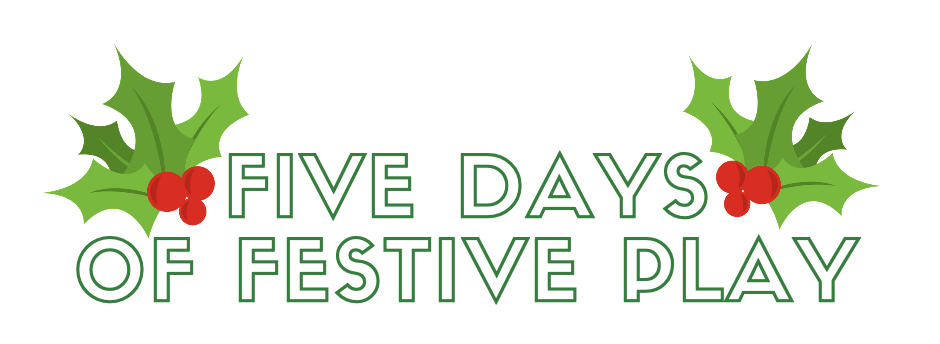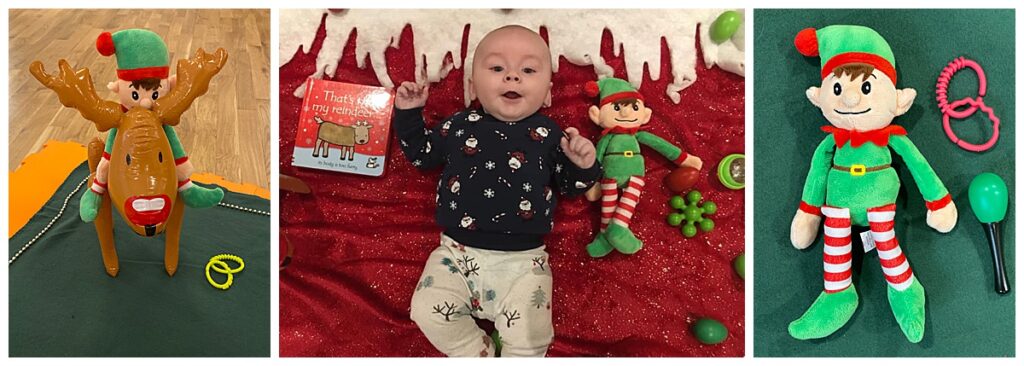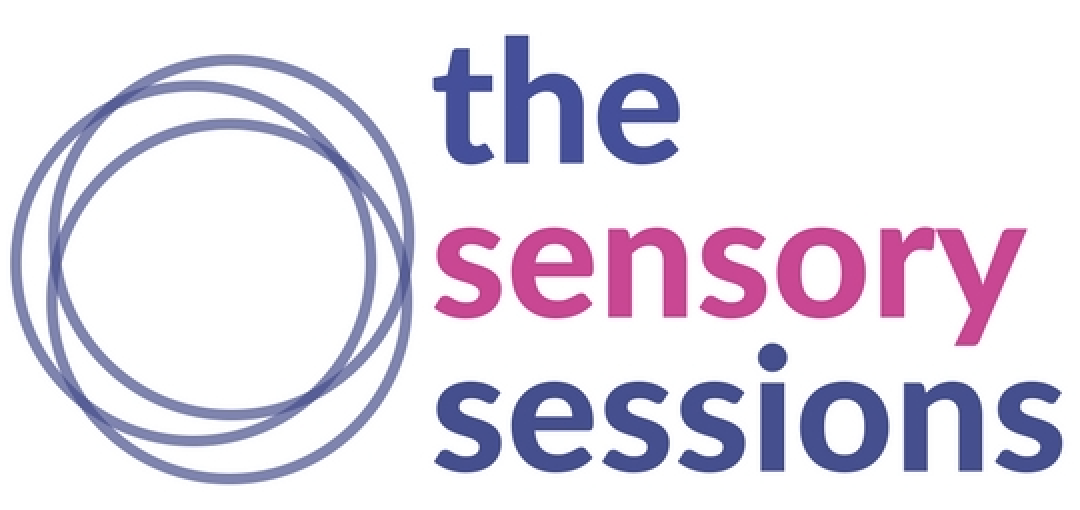Five Days of Festive Play
We are so excited to welcome you along to five days of festive play!

Each day between 15th of December and 22nd December we’ll be posting daily festive play ideas that you can do with your baby, toddler or preschooler at home!
Register for our play emails on the button below and to get an invitation to our Facebook group!
We can’t wait to welcome you along to play!
Day one - texture tub
Our sense of touch is one of our foundation senses, at the very bottom of that pyramid of learning so it is really important that we introduce lots of textures into our baby’s play and that we continue to play with textures as our toddler’s grow.
Today we would like you to put together a Festive Texture Tub. Pop in 5 toys that feel different to touch, you can include some festive toys too. Bonus points if your little one would need to hold them differently. Try not to be tempted to add in lots of toys, we really want our little ones to focus on a small selection of toys helping them practice skills, extend play and build up concentration.
How to use a texture tub with your baby, toddler or preschooler
For our youngest babies, in lying or tummy time, we are letting them touch each toy. Popping them down, lying on their side naturally brings their hands together enabling both hands to engage with the toy.
For our sitters we are looking to put the toys in front of them and encouraging them to engage with the toys using both hands to bring them out of the tub and do lots of holding and touching.
For our movers it is all about getting them moving alongside engaging with the textures.
For our toddlers this is a great activity for starting to discover and name toys. You can put things together around themes, around a book is an amazing idea and pull out toys that relate to the book as you read a story together.
For our preschoolers we can name the toys, feel and touch them through a bag to identify them. We can pop them on a piece of paper and draw round them to do some matching games and we can remove one from the paper as a memory game asking our little ones to work out which item is missing. We can also ask for their help choosing the five toys and ask them to describe textures too.
Repeat it often
Once you are finished, put the toys back in their tub and repeat it over the coming days, repetition is amazing for baby brain development!

Day two - visual development
Contrast play is amazing for your baby, as it is great for helping their visual development. When your baby is born they see in light and shade so things that are high contrast are really visually interesting for them. It is also really good for helping to strengthen the tiny muscles in the back of their eyes.
Black, white and red is a really good combination to start with as it involves contrast and one of the first colours that our little ones can see in focus. It is important to repeat contrast play often with our babies, toddlers and our preschoolers as it works on each area of their brain. They use their frontal lobe for their motor functions, their parietal lobe for their touch and sensory input, occipital lobe for their vision, cerebellum for their co-ordination and temporal for their memory & auditory processing. So much benefit from one little activity, please repeat it often!
We. have attached some contrast cards for you to use with your little one at home.
A fantastic play opportunity for your toddler or preschooler can be introduced using building blocks (wooden, plastic or duplo work well) Blocks are a fantastic resource for allowing your little ones to develop their one motor skills, hand-eye co-ordination and spatial awareness. Research also suggests that block play as a child is linked with higher mathematical achievement!
Play alongside your little one, help them build a tower, talk to them about which blocks should be placed where and why. Work cooperatively with your little one to create structures, talking about what you are building as you go.
Toddlers and preschoolers love to collect and transport items so while playing with blocks provide some small bags, baskets or boxes for your little one to pack and move to where you are building your structure. Children make sense of the world around them by exploring these patterns of behaviour so by providing them with opportunities to transport you are helping support brain development!
Contrast cards – animal contrast cards
Day three - stories
Books are a great way to start having conversations with our babies. Lots of research indicates that babies who are exposed to books from a younger age have better communication skills, listening skills and vocabulary so it is really important that we share stories with our little ones right from the start.
Today we would like you to make reading a story a real event! We are adding toys alongside the story to increase the sensory input that our baby’s have exposure too.
Choose a book that you are able to compliment some toys alongside, even if it is just a toy that matches the colour of the cover! Choose 4-5 toys, we are aiming to increase our little one’s concentration span so you don’t need to include all of the toys, just a few would be amazing. Think about the textures you are adding and try to increase the textures that they have exposure to during your session, bonus points if your book includes textures!
Talk your little one through what they are looking at, explain what is happening in the book and help them process the tactile experience of storytime. Using the toys alongside the story will help your toddler’s focus and attention and can help to make story time more interactive for them. The toys can help to stimulate their imaginations and lift the words off the page. A simple 8 – 10 minute play session done in this way has so many benefits for baby brains and sensory development.
Your baby is developing so many skills including –their sense of touch and their brains ability to process textures. They are working on their visual development and controlling those tiny muscles in the back of their eyes. They are working on their co-ordination, their balance, using both sides of their body and their motor planning skills. They will be improving their ability to screen input as they listen to your voice, increasing their attention span, and they are listening to your voice so using lots of their auditory processing skills too.
Share a story at a time that your little one is calm and alert and please don’t be concerned if they only manage a page or two the first time you do it just try again the next day. We hope you have lots of fun reading with your little one.
Day four - tracking
Today we are going to work on visual tracking and tracking a noise. At birth our visual system is the least developed so there are lots of activities we can do with our little ones to support their visual system before it is completely developed by age 2.
Using a small finger puppet or small soft toy hold it over their eye line. Holding it steady allows them to work the little muscles at the back of their eyes to focus. Begin to move the toy slowly back and forth over the eye line (aiming towards their nose). Try little zooms down towards their nose which really helps with your little one’s binocular vision, let the toy tickle their nose! Practise this activity often to help them work on those important little eye muscles.
At birth your little one’s sense of hearing is most developed but we can still help them by exposing them to lots of different noises and to directional noise. Get a small toy that makes a noise, for example a rattle or shaker or bell. (Or fill a small empty bottle with rice, dried beans, small pasta to make a shaker). Hold the toy over to one side and see if you can get your little one to turn their head in response to the noise. Repeat this to the other side and repeat often to practise those motor skills involved in turning their head.
For your older little ones see if you can encourage them to shake the toy themselves to make the noise, can they use their other hand? Can they hold something in each hand and shake them both to make a noise?
For our toddlers and preschoolers we will be tracking a ball, so try sitting on the floor facing your little one with your legs apart, encourage your little one to copy you. Roll the ball gently towards your little one, can they catch it and roll it back. By sitting with their legs apart they have created bumpers increasing their chance of catching the ball. Once they have mastered this you can increase the distance between you so they have to track the ball for longer. To increase the challenge further you can sit cross-legged removing the bumpers created by their legs and eventually stand up.



